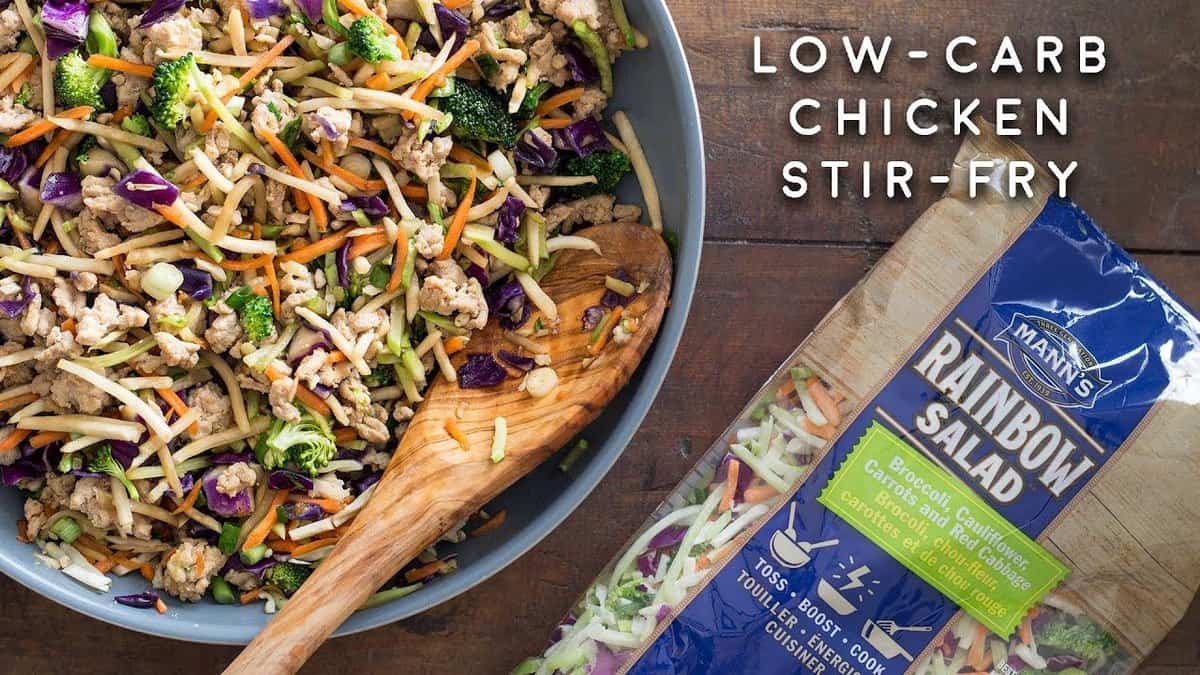Craving vibrant, flavorful stir-fries without the carb overload? This guide unveils the secrets to creating incredibly delicious, low-carb stir-fries that are both satisfying and healthy. We’ll journey through a world of crisp-tender vegetables, zesty sauces, and perfectly cooked proteins, transforming your culinary landscape with exciting flavor combinations and simple techniques. Prepare to elevate your weeknight meals with stunning ease and incredible taste.
From selecting the perfect low-carb vegetables and crafting mouthwatering sauces to mastering protein cooking techniques and assembling the ultimate stir-fry, this comprehensive guide leaves no stone unturned. Discover the nutritional benefits of each ingredient, learn essential chopping and cooking methods, and unlock the power of flavorful marinades. We’ll explore diverse serving suggestions and creative variations, ensuring your low-carb stir-fry experience is nothing short of extraordinary.
Protein Choices for Low-Carb Stir-Fries
Choosing the right protein is crucial for a satisfying and nutritionally balanced low-carb stir-fry. The protein you select not only provides essential amino acids but also impacts the overall flavor profile and texture of your dish. Consider factors like cooking time, desired texture, and nutritional benefits when making your selection.
Protein Options and Cooking Methods
The following list details five popular protein choices, their ideal cooking times, and recommended methods for achieving optimal results in a low-carb stir-fry. Each option offers unique nutritional advantages and complements low-carb vegetables beautifully.
- Chicken Breast: Tender chicken breast cooks quickly, usually within 5-7 minutes when sliced thinly. A quick sear in a hot wok or pan before adding vegetables ensures a juicy and flavorful result. Marinate for at least 30 minutes for enhanced flavor.
- Shrimp: Delicate shrimp require only 2-3 minutes of cooking time. Their mild flavor pairs well with a variety of sauces and vegetables. Overcooking can make them tough, so careful attention to timing is essential.
- Firm Tofu: Pressing firm tofu to remove excess water is vital before cooking. It then takes approximately 5-7 minutes to achieve a crispy exterior and tender interior. Marinating tofu enhances its flavor significantly, compensating for its naturally bland taste.
- Sirloin Steak: Thinly sliced sirloin steak cooks quickly, around 3-5 minutes, in a hot stir-fry. Its rich, savory flavor provides a robust foundation for the dish. Marinating helps tenderize the meat and add depth of flavor.
- Ground Turkey: Lean ground turkey cooks rapidly, browning in just 5-7 minutes. Its versatility allows for easy incorporation of various spices and sauces. It’s a great option for a heartier stir-fry.
Nutritional Benefits and Flavor Complements
Each protein option offers distinct nutritional advantages that complement the low-carb vegetable components of the stir-fry.
- Chicken Breast: A lean protein source rich in protein and low in fat, chicken breast provides essential amino acids and supports muscle growth. Its mild flavor allows the vegetables and sauce to shine.
- Shrimp: An excellent source of protein and omega-3 fatty acids, shrimp contribute to heart health and overall well-being. Its delicate flavor pairs well with lighter sauces and a variety of vegetables.
- Firm Tofu: A plant-based protein source, tofu is rich in iron and provides a good source of protein for vegetarians and vegans. It absorbs flavors well, making it a versatile addition to stir-fries.
- Sirloin Steak: A good source of iron and B vitamins, sirloin steak offers a satisfying and protein-rich element to the meal. Its robust flavor balances well with strong-flavored vegetables and sauces.
- Ground Turkey: A leaner alternative to ground beef, ground turkey is a good source of protein and iron. Its mild flavor makes it adaptable to various spice blends and sauces.
Protein Marinades for Enhanced Flavor and Texture
Marinating proteins before stir-frying enhances both their flavor and texture. The marinade tenderizes the meat or tofu and infuses it with aromatic spices and flavors.
- Chicken: A marinade of soy sauce (low-sodium), ginger, garlic, and a touch of sesame oil creates a savory and slightly sweet flavor profile.
- Shrimp: A simple marinade of lime juice, garlic, and chili flakes adds a bright, zesty flavor to shrimp.
- Tofu: Marinate firm tofu in a mixture of soy sauce, rice vinegar, sesame oil, and ginger for a flavorful and slightly tangy taste.
- Sirloin Steak: A marinade of soy sauce, Worcestershire sauce, garlic, and black pepper tenderizes the steak and imparts a rich, savory flavor.
- Ground Turkey: A marinade of chili powder, cumin, garlic powder, and onion powder adds a Southwestern flair to the ground turkey.
Step-by-Step Guide to Creating a Delicious Low-Carb Stir-Fry

This guide provides a detailed recipe for a vibrant and flavorful low-carb stir-fry, emphasizing quick cooking techniques to preserve nutrients and achieve optimal texture. We’ll cover ingredient selection, preparation, and cooking steps, ensuring a delicious and satisfying meal. Remember to adjust spice levels and protein choices to suit your personal preferences.
Ingredient Preparation and Measurement
Proper preparation is key to a successful stir-fry. Precisely measured ingredients ensure balanced flavors and optimal cooking times. The following quantities are a guideline; feel free to adjust based on your serving size and preferences.
- Protein (150g): Choose your preferred protein source, such as chicken breast (cubed), shrimp (peeled and deveined), or thinly sliced steak. Marinate the protein for at least 15 minutes in soy sauce (1 tbsp), sesame oil (1 tsp), and ginger (1 tsp, grated) for enhanced flavor.
- Vegetables (300g): Select a colorful array of low-carb vegetables. Good choices include broccoli florets, sliced bell peppers (red, yellow, orange), sliced mushrooms, and snap peas. Wash and chop all vegetables into bite-sized pieces for even cooking.
- Sauce (50ml): Whisk together low-sodium soy sauce (2 tbsp), rice vinegar (1 tbsp), sesame oil (1 tbsp), honey or a low-carb sweetener (1 tbsp), and a pinch of red pepper flakes (adjust to your spice preference). For a thicker sauce, add 1 tsp of cornstarch mixed with 1 tbsp of water.
- Garlic and Ginger (1 tbsp each): Finely mince fresh garlic and ginger for a potent aromatic base. Pre-mincing allows the flavors to infuse during cooking.
- Optional additions: Consider adding a handful of chopped scallions or cilantro for a fresh garnish at the end.
Stir-Fry Cooking Technique
High heat and quick cooking are essential for a successful stir-fry. This preserves the vibrant colors and crisp-tender texture of the vegetables, while ensuring the protein cooks thoroughly without becoming tough.
- Heat the Wok/Pan: Heat a wok or large skillet over high heat. Add 1 tbsp of sesame oil. The oil should shimmer almost instantly.
- Cook the Protein: Add the marinated protein to the hot wok and stir-fry for 3-5 minutes, until cooked through. Remove the protein from the wok and set aside.
- Sauté Aromatics: Add the minced garlic and ginger to the wok and stir-fry for 30 seconds, until fragrant. Avoid burning them by keeping the heat high but stirring constantly.
- Stir-fry Vegetables: Add the vegetables to the wok and stir-fry for 3-5 minutes, until they are crisp-tender but still retain a slight bite. Continuous stirring prevents sticking and ensures even cooking.
- Combine and Simmer: Return the cooked protein to the wok. Pour the sauce over the protein and vegetables. Stir-fry for 1-2 minutes, allowing the sauce to thicken and coat everything evenly. The sauce should lightly coat the ingredients, creating a glossy finish.
- Serve Immediately: Garnish with chopped scallions or cilantro and serve immediately over cauliflower rice or zucchini noodles for a complete low-carb meal.
Dietary Adjustments and Variations
This recipe is easily adaptable to various dietary needs and preferences.
- Spice Level: Adjust the amount of red pepper flakes to control the spice level. For a milder stir-fry, omit the red pepper flakes altogether. For extra heat, add a chopped chili pepper.
- Protein Choice: Substitute the protein with any low-carb option you prefer, such as tofu (for vegetarians), pork, or even firm fish like cod or halibut. Adjust cooking time accordingly.
- Vegetable Selection: Feel free to substitute the suggested vegetables with others that are low in carbohydrates, such as bok choy, asparagus, or shirataki noodles.
- Sauce Modification: Experiment with different sauces or adjust the existing sauce to your taste. For example, you can add a splash of fish sauce or oyster sauce for umami flavor.
Mastering the art of the low-carb stir-fry is now within your grasp. With this guide as your culinary compass, you’ll confidently navigate the world of vibrant vegetables, tantalizing sauces, and perfectly cooked proteins. Remember, the key lies in the precision of your knife work, the mastery of high-heat cooking, and the creative exploration of diverse flavors. So, gather your ingredients, ignite your wok, and embark on a delicious low-carb adventure that will tantalize your taste buds and nourish your body. Bon appétit!
Essential FAQs
Can I use frozen vegetables in low-carb stir-fries?
Yes, frozen vegetables work well, but ensure they’re completely thawed and patted dry before stir-frying to prevent excess moisture.
How do I prevent my stir-fry from becoming soggy?
Use high heat, add ingredients in stages, and don’t overcrowd the wok. Ensure your vegetables are properly prepped (blanched if necessary) to maintain their texture.
What are some good low-carb substitutes for soy sauce?
Coconut aminos, tamari (gluten-free versions available), or low-sodium Worcestershire sauce are excellent alternatives.
Can I make a large batch of stir-fry and store it for later?
Yes, but store the stir-fry separately from the sauce to prevent the vegetables from becoming soggy. Reheat gently and add the sauce just before serving.
Are there any low-carb noodles I can use?
Shirataki noodles, zucchini noodles (zoodles), or kelp noodles are popular low-carb alternatives to traditional noodles.


